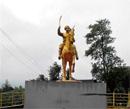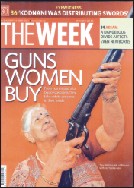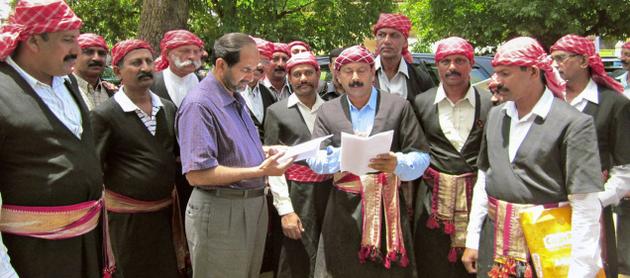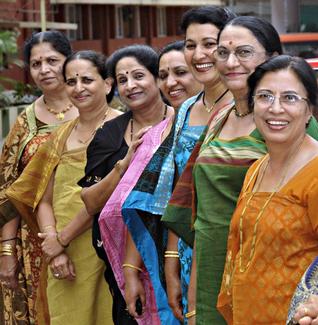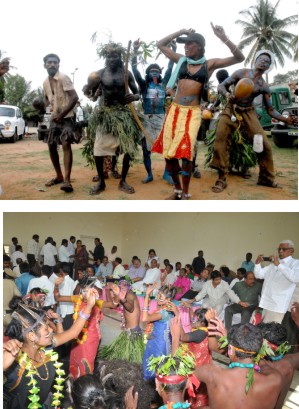
Rameshwar Oraon, Chairperson, National Commission for Scheduled Tribes, addressing tribals at Dr. B.R. Ambedkar Bhavan in Hunsur yesterday, accompanied by other members of the Commission. Pictures centre and right show the tribal dances performed to welcome the Central team.
Mysore, Nov. 9 (RK&RNN)
Tribal people have every right to collect and sell Minor Forest Produces (MFP) and no one could interfere with this, observed Rameshwar Oraon, Chairperson, National Commission for Scheduled Tribes.
Addressing members of the tribal community at Dr. B.R. Ambedkar Bhavan in Hunsur after visiting several Haadis in H.D. Kote taluk of Mysore district yesterday, he said the Union Government was taking steps to fix a minimum price for the MFP to avoid exploitation from middle men.
He also added that The Scheduled Tribes and Other Traditional Forest Dwellers (Recognition of Forest Rights) Act, 2006 made all tribal people living in the forest eligible for title deeds of their lands and urged Adivasis to take benefits due to them.
He also elicited the opinion of tribal people and others who participated in the meeting on whether they were getting the benefits given by the Centre.
Stating that the tribals would be given compensation four times higher than the existing value of the land if the same was acquired for any government purpose, Oraon added that the Centre was planning to bring legislation in this regard.
Many of those present complained that they were denied benefits like schools, angan-wadi centres, drinking water and ration under the Public Distribution System (PDS) to which Oraon replied that he would take up the issue with the State Chief Secretary at a meeting scheduled to be held today and added that he would also discuss it with Deputy Commissioner and CEO of Mysore Zilla Panchayat.
Food security to tribals
It is reported that Rameshwar Oraon has directed the District Administration to provide food security to tribals and adivasis living in the periphery of forests through Fair Price shops and also urged the District Administration to provide them alternative land for agriculture.
Stressing for education to tri-bal children at Ashraya Schools from first to seventh standards, Oraon instructed ADGP Chikkanur to withdraw false cases filed against tribals and also called for making arrangements for selling of products manufactured by tribals through Lamp Societies at good prices.
He directed early completion of probe into the missing cases of Jiyamballi Raju and Hunsekoppa Bheemasena besides ensuring avoidance of harassment of tribals by forest officials.
A traditional welcome was accorded to the visiting team by tribals who performed folk dan-ces following which Prasanna, Convenor of South India Cell for Human Rights Education and Monitoring (SICHREM) and Vaddaragudi Chikkanna gave a presentation of problems being faced by tribals.
The team consisting of Rameshwar Oraon, Commission members Kamala Kumari, B.L. Meena, Jt. Secretary Aditya Mishra, Dy. Director K.D.Bansar, SC/ST Regional Office (Bhopal) Asst. Director R.K.Dubey and others who arrived from Bangalore in the morning drove straight to Morarji Desai School Hostel in Hunsur for an inspection.
Dy. Commissioner P.S. Vastrad, ZP CEO Dr. Ajai Nagabhushan, SP R.Dileep, MLAs Chikkanna and Manjunath, Asst. Commissioners, Tahasil dars and other officials provided necessary information to the team.
source: http://www.StarofMysore.com / Home> General News / November 09th, 2012
